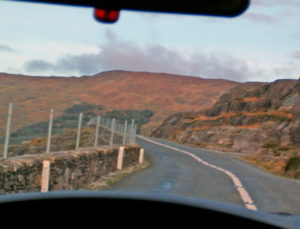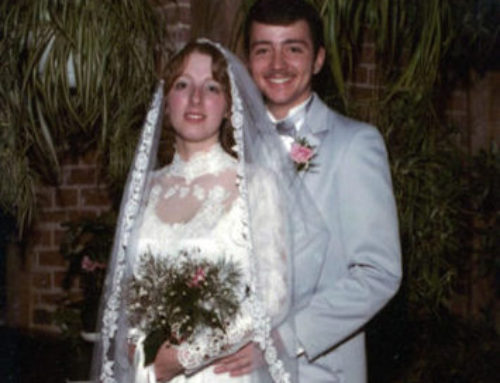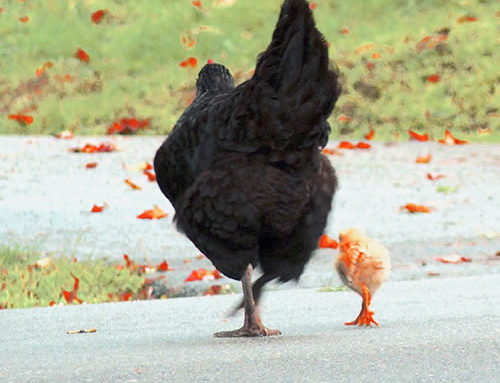 On one fateful Saturday—October 23, 2004, to be precise—my husband, George, and I, and Jack and Ann (George’s brother and sister-in-law) boarded a plane for Shannon, Ireland. The trip had been decided on and planned so rapidly I did not have time to be excited, until that was, after the plane took off. We ate, read, and attempted to sleep on the eight-hour overnight flight with seats so close together that my knees brushed the one in front of me while George’s shoulders pushed me slightly into the aisle. (At the time I was 5′ 3″ and a buck thirty, which is not the case today.) However, all I could think about was: “Could they possibly put any more people on this plane? Did I pack enough underwear? and how could George possibly sleep at a time like this?”
On one fateful Saturday—October 23, 2004, to be precise—my husband, George, and I, and Jack and Ann (George’s brother and sister-in-law) boarded a plane for Shannon, Ireland. The trip had been decided on and planned so rapidly I did not have time to be excited, until that was, after the plane took off. We ate, read, and attempted to sleep on the eight-hour overnight flight with seats so close together that my knees brushed the one in front of me while George’s shoulders pushed me slightly into the aisle. (At the time I was 5′ 3″ and a buck thirty, which is not the case today.) However, all I could think about was: “Could they possibly put any more people on this plane? Did I pack enough underwear? and how could George possibly sleep at a time like this?”
Though the plane was packed to the gills and left me with a crushing, claustrophobic, lifelong phobia, the trip was, for the most part, uneventful. I did receive my first stamp in my brand-new passport, and no luggage was lost; though for a moment it was close because, like Ann, everyone had black luggage with a tasteful white ribbon marking ownership. Not for the first time was I glad for my paternal genetics for an affinity to bright colors. Even customs was not a hassle. Now all we had to do was rent the car. This was when the true adventure began, and Jack became the hero because he volunteered to drive.
The car that had been reserved turned out to be too small to fit the four of us with eight bags of luggage, and it did not meet the approval of our guys. The men searched the lot like hounds looking for a lost bone and found a more appropriate car, a Beamer. The descriptions of quaint, narrow, twisting streets of Irish towns and countryside never came into anyone’s minds as we settled in to the luxury sports car, which was as wide as some of the lanes we would be traversing. Never mind the fact that the cars were driven on the left side of the road or that it was a standard because “only wusses drove a sports car with an automatic transmission”—as I was told by two right-handed drivers.
We left the airport with Jack piloting this seemingly unnatural car and George in charge of navigation. We made a left, a left, and a right.
Now what?
Oh my God!!!
As we met our first roundabout, the stress factor in the front seat increased to the point that the air conditioner had to be used on that cool, autumn morning. Thank God the seats were black leather and didn’t show the stains of urine? or sweat? At that point it was a potato-patato-sort-of-moment.
Before we could relax with the joy of successfully navigating the roundabout, the next challenge for our piloting team was a car coming at us on the wrong side of the road! A debate ensued at a speed only true Massachusetts’s natives could have, thirty-five words in three seconds. The results narrowed down to: This was Ireland; They were okay, and we were in proper flight position. (Expletives and prayers have been deleted.)
As we passed a McDonald’s sign one-hundred feet in the air, the memento of home only made us feel even more out of place in this country. The familiar restaurant with its greasy food sounded good to all, a piece of home, comfort food, but my unspoken random thought was: Why did Ireland have fast food? Weren’t they too laid-back of a country to succumb to the commercialism of the cholesterol king? We pulled over under the guise of looking for the directions to Inish Beg, our accommodation for the week, the golden arches peaking over the trees, mocking us.
The men looked in the trunk, with grunts and groans moving luggage that stretched the airline weight limit by a whisper until finally they asked the back seat, where their wives sat, for what they were looking for. Ann calmly informed the stressed-out, sweating men that the documents had been safely put away in her purse and asked if they would like them. She handed them over and calmly inquired if I would like some gum as they grumbled and repacked the trunk into its complex, compact puzzle. It did not go without notice that the brothers stayed outside to recuperate with Jack sucking on a cigarette like an oxygen lifeline as cars whizzed by, sped on by people with places to go. Who knew where they were going, but every one of a gave a small sigh of envy as we watched them pass.
Courage by nicotine fortified half the group and silent prayers the rest as the men moved our “large ship” through the narrow channels that this fair country called roads, roads that, in my opinion, were only meant for go-carts. This was pre-GPS days when no soothing voice of your choice guided you to your destination with little or no error. We had a map, emailed directions, and George’s GPS, which was nothing more than a small block with a one-by-three-inch blank screen that left a trail of bread crumb dots showing where you had been for the past twenty miles; then it would rewrite over the information. The signage was poor or nonexistent until you figured out where they had hidden it; pot holes were a national tourist attraction, and we had the added bonus of a pilot who was jet lagged and could only focus on driving. The co-pilot had all the tasks of navigating, speed monitoring, and reminding Jack there was not a breakdown lane, only a ditch, and to repeat the mantra: “Keep to the left.”
We only became lost a couple of times because the navigator needed sleep and the replacement was directionally challenged. I was promptly replaced within fifteen minutes and the rest of the trip went well. We arrived in the southwest of Ireland with the car undamaged and our sense of humor still intact. We were at Inish Beg, a working farm with beautifully renovated outbuildings turned into rental vacation units.
We dumped our bags in our rooms with an air of relief. Ann and I just sat. The act of watching and listening to our husbands’ drive had been such a strain we wanted to enjoy being freed from our mode of transport. That was not the case with the driver and crew. The adrenalin pumped through them in such a state that they willingly chose to drive back into town for food. All I was up for was fasting and personally feeding them the protein bars from my purse.
To truly understand why we didn’t go, even though it was our first day in Ireland, a person needs to fully grasp that Irish roads, if filled with water, would be narrow canals where one would be hard pressed to allow two kayaks to pass. In all our time there, I don’t remember a straight road, though that might be from the ordeal of being a backseat passenger. The vacation brochures with their professional photos of quaint towns with stone buildings flanking narrow, curvy streets and flower boxes filled with a riot of colorful flowers are designed to make us forget that we must drive on them and that the cars are miniatures of anything driven in the United States.
The most memorable part of Ireland’s infrastructure are its roads with a white, zigging-zagging line down the middle. They are found on the business streets in small towns, and I dubbed them chicken lanes. For those of you unfamiliar with the game of chicken, it is when two vehicles, usually manned by teenage males encouraged by their friends, drive straight towards each other on a narrow, back road. The first car to veer off to the side loses, usually into a ditch that requires a call to AAA along with an explanation to a parent the following morning as to why the windshield wiper is missing. These are the roads where this game was invented.
Chicken lanes are wide enough for two-way traffic; however, they allow parking on both sides. The good people of Ireland turned a two-lane road into an alley with only enough room for one small car to pass comfortably, even though traffic passes in both directions. That is why the jagged line is painted on the pavement, to make the bold statement: First come, first served.
Whenever we approached a chicken lane, I could hear the natives silently laughing at our tentative approach. These brothers were a long way from being teenage drivers, and this wasn’t their parent’s car. The “good luck” that came clairvoyantly to us from the good people by the road was clearly inadequate to meet our need. The cars that lined either side of us had broken side mirrors, some simply cracked but others limply hanging by their wires, too broken to do anything more than dangle. Our anxiety ramped up. Obviously, some people did not back down.
I would like to have said driving became easier to watch, but, alas, the men foolishly were the only registered drivers for the rental car. It was a daily debate on whose turn it was to not drive. The keys would sit on the counter, where they were simultaneously glared at and ignored until we left. Sometimes, ladies, it is good to have an old-fashioned gentleman who insists on doing all the driving. To this day, I sit in the passenger seat with relief and without complaint. (Shh, I am ambidextrous and probably could have easily shifted with my left hand and drove with less stress, but we won’t go there.)
The week wore on, and the sights, which mostly happened through the lens of my camera, were amazing and beautiful. I came back with some beautiful pictures of South Cork, but I mostly saw them through a lens. The quaint country roads were lined with stone walls that felt like the Great Wall of China as we drove beside them inside the car. The soft seats, which we sunk into luxuriously, left us riding six inches off the floor of the already low-slung Beamer. We looked up at the walls of stone with an occasional grove of trees or bushes nestled behind them, breaking up the view we couldn’t see. I am nothing if not adaptable, and with no place to pull over, I learned how to take pictures on the fly. I would raise my camera to the top of the back seat window—I had one of the first digital cameras, a little Fuji—press the button halfway down as we passed a clearing to focus the lens, and then quickly press the button at the next opening. Voila! I had a view. The following meal we would all look at the pictures and everyone would be amazed because we had passed old ruins and quaint farms with sheep or cows that only my camera could see.
This country is the only place I have ever visited that I wanted to stay. It felt like home. How could I not love a country where cows, calmly chewing their cud and inspecting license plates, are found in the parking lot of a beach or where sheep consider barbwire fencing a suggestion that they rarely take?—no farmer or shepherd in sight, looking with a disgruntled face for lost animals. The old woods and vegetation around the ruins of Blarney Castle make me feel like one of the wee people. There are palm trees growing beside evergreens. Folks are friendly. Asking for directions can take an hour as we cover the Red Sox’ winning the World Series or the politics going on in Washington, D.C.
On the way home, the “cool car,” which gave everyone backaches and with cupholders that broke the first time we used them, did not fail us. As we passed through one of many potholes, a titanium tire rim on the left back wheel bent. We all got out and looked down at the broken rim of doom. We all had to see the horror for ourselves. I heard the clear voice of the rental agent saying as we were about to drive away, “This is a good car, and it is well insured. Well, except the rims.” The memory made my head hurt.
We stood at the end of someone’s driveway while the men worked around puddles and to the sound of passing cars, grunting and groaning as they pulled apart the trunk to get at the spare tire. We had to stop at a sister rental agency and pick up a replacement car because titanium rims cannot be fixed. In the new car, Ann and I marveled at the comfort of the back seat. I loved that I could see over the stone walls. George commented on how the back held all our suitcases so easily—and Jack said it was the exact same car they originally were going to give us. I would bet solid money that car would not have cost us $1,500 for a new rim.
Moral of this story: The natives know best.



